University Essay: Challenges and Issues in Change Management
VerifiedAdded on 2023/06/08
|6
|1462
|244
Essay
AI Summary
This essay delves into the critical challenges encountered in change management processes within organizations. The introduction highlights the increasing importance of change management and the associated complexities. The core of the essay focuses on three major challenges: lack of consensus among stakeholders due to differing interests, employee resistance stemming from concerns about job security or negative impacts, and the rapid pace of change in the business environment, which can render change initiatives obsolete. The essay explores these challenges through a critical review of academic literature, examining how different authors approach these issues. The literature review assesses the authenticity and reliability of the sources, while also acknowledging that some reliance on secondary information and a lack of comprehensive coverage of all aspects of change management challenges exist. The essay concludes by emphasizing the importance of addressing the gap between managers and employees and the impact of external business factors on change management success.
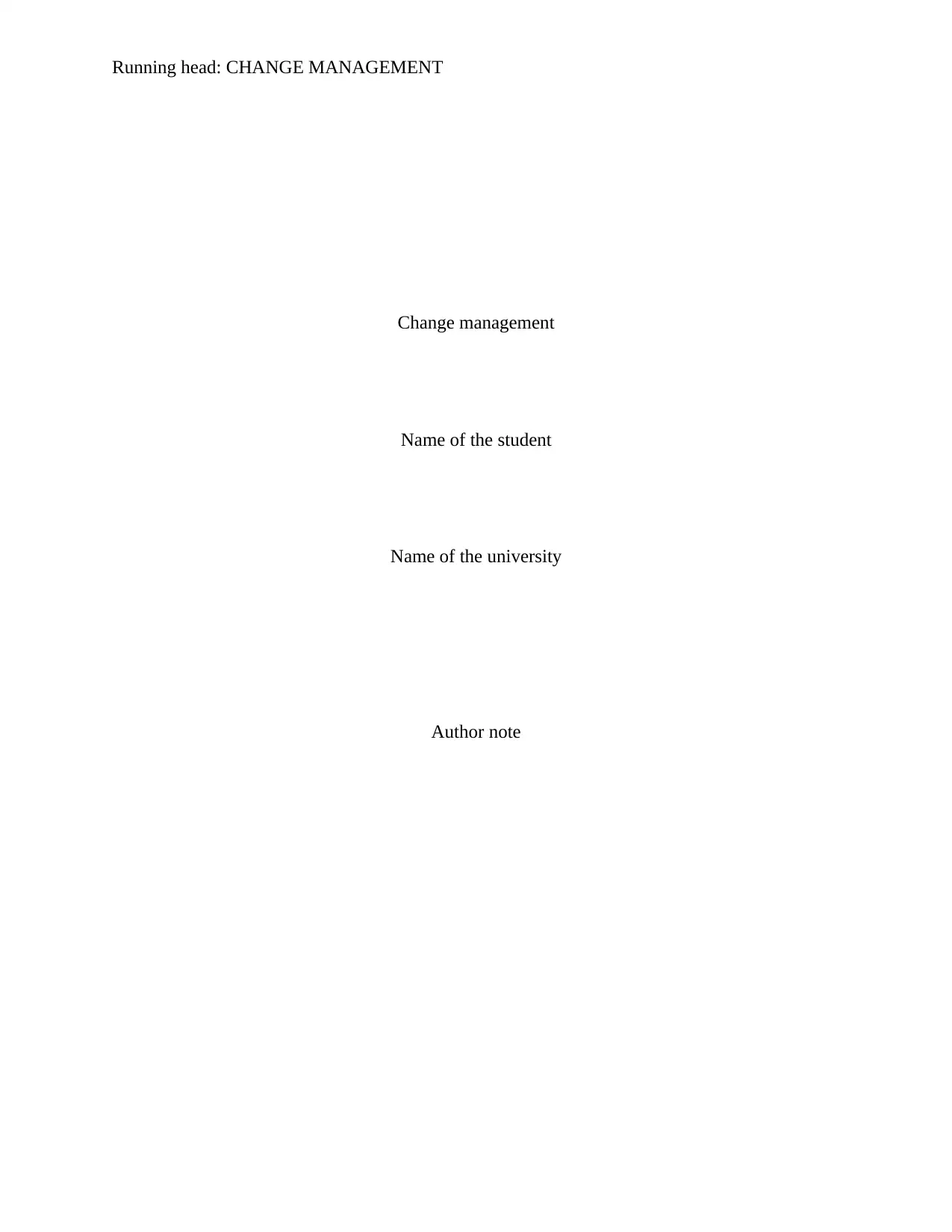
Running head: CHANGE MANAGEMENT
Change management
Name of the student
Name of the university
Author note
Change management
Name of the student
Name of the university
Author note
Paraphrase This Document
Need a fresh take? Get an instant paraphrase of this document with our AI Paraphraser
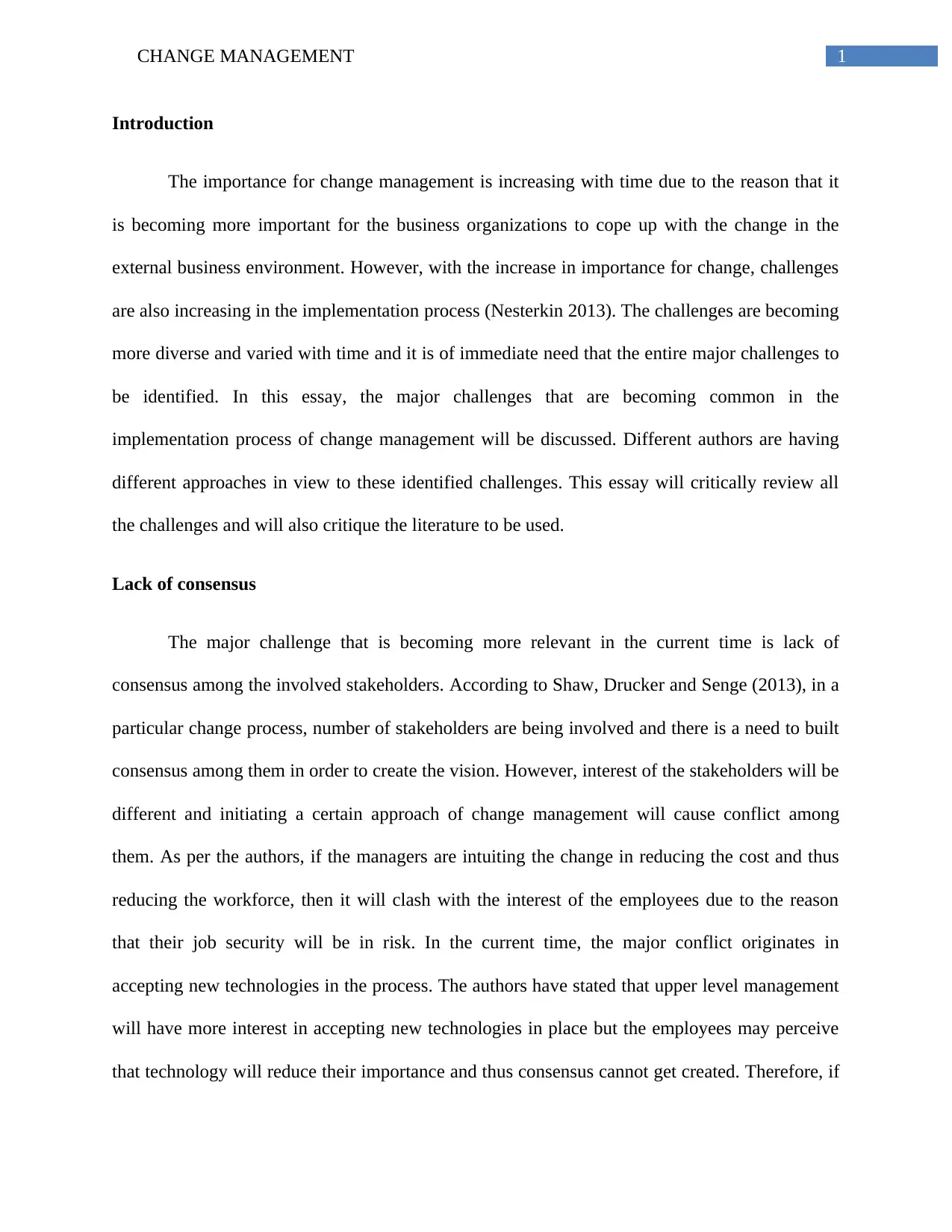
1CHANGE MANAGEMENT
Introduction
The importance for change management is increasing with time due to the reason that it
is becoming more important for the business organizations to cope up with the change in the
external business environment. However, with the increase in importance for change, challenges
are also increasing in the implementation process (Nesterkin 2013). The challenges are becoming
more diverse and varied with time and it is of immediate need that the entire major challenges to
be identified. In this essay, the major challenges that are becoming common in the
implementation process of change management will be discussed. Different authors are having
different approaches in view to these identified challenges. This essay will critically review all
the challenges and will also critique the literature to be used.
Lack of consensus
The major challenge that is becoming more relevant in the current time is lack of
consensus among the involved stakeholders. According to Shaw, Drucker and Senge (2013), in a
particular change process, number of stakeholders are being involved and there is a need to built
consensus among them in order to create the vision. However, interest of the stakeholders will be
different and initiating a certain approach of change management will cause conflict among
them. As per the authors, if the managers are intuiting the change in reducing the cost and thus
reducing the workforce, then it will clash with the interest of the employees due to the reason
that their job security will be in risk. In the current time, the major conflict originates in
accepting new technologies in the process. The authors have stated that upper level management
will have more interest in accepting new technologies in place but the employees may perceive
that technology will reduce their importance and thus consensus cannot get created. Therefore, if
Introduction
The importance for change management is increasing with time due to the reason that it
is becoming more important for the business organizations to cope up with the change in the
external business environment. However, with the increase in importance for change, challenges
are also increasing in the implementation process (Nesterkin 2013). The challenges are becoming
more diverse and varied with time and it is of immediate need that the entire major challenges to
be identified. In this essay, the major challenges that are becoming common in the
implementation process of change management will be discussed. Different authors are having
different approaches in view to these identified challenges. This essay will critically review all
the challenges and will also critique the literature to be used.
Lack of consensus
The major challenge that is becoming more relevant in the current time is lack of
consensus among the involved stakeholders. According to Shaw, Drucker and Senge (2013), in a
particular change process, number of stakeholders are being involved and there is a need to built
consensus among them in order to create the vision. However, interest of the stakeholders will be
different and initiating a certain approach of change management will cause conflict among
them. As per the authors, if the managers are intuiting the change in reducing the cost and thus
reducing the workforce, then it will clash with the interest of the employees due to the reason
that their job security will be in risk. In the current time, the major conflict originates in
accepting new technologies in the process. The authors have stated that upper level management
will have more interest in accepting new technologies in place but the employees may perceive
that technology will reduce their importance and thus consensus cannot get created. Therefore, if
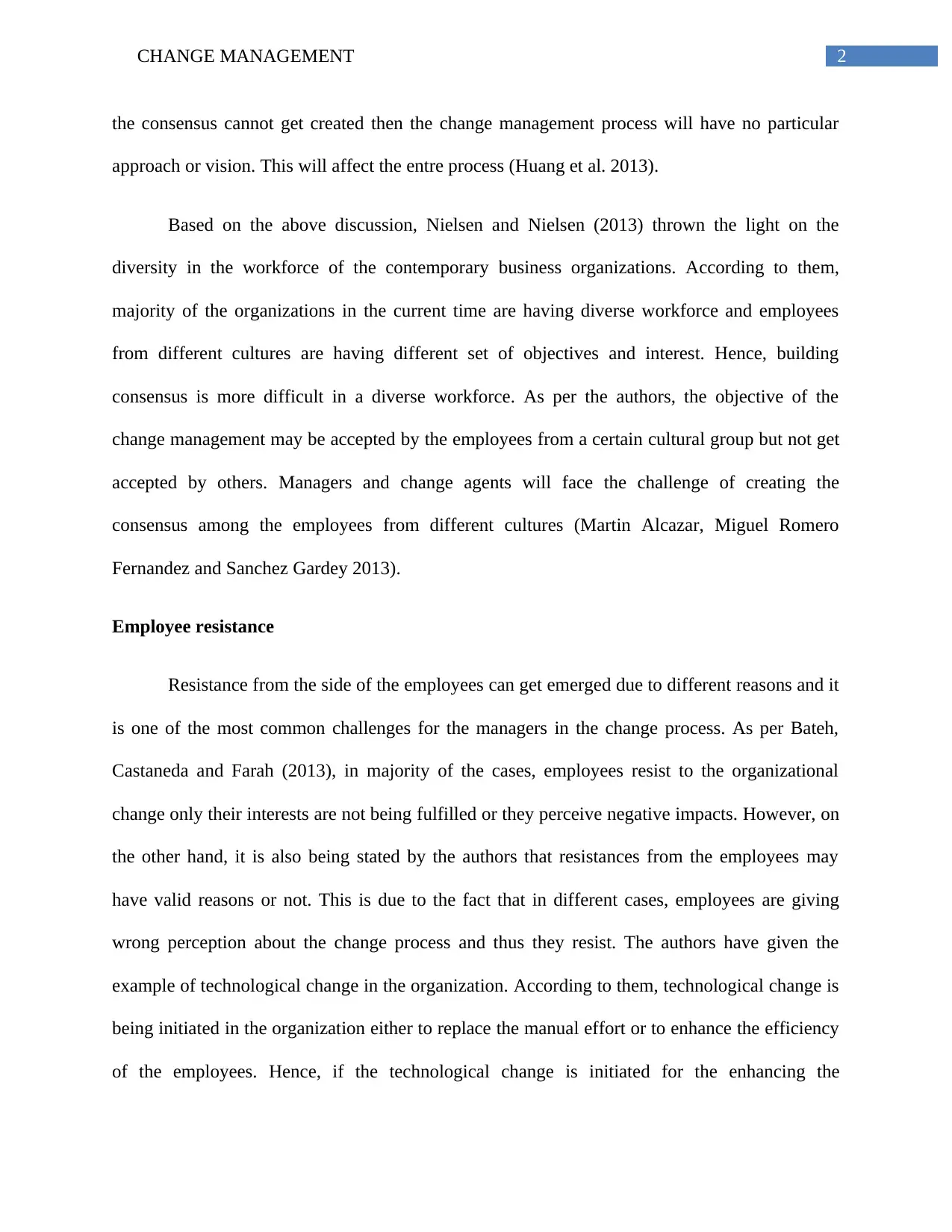
2CHANGE MANAGEMENT
the consensus cannot get created then the change management process will have no particular
approach or vision. This will affect the entre process (Huang et al. 2013).
Based on the above discussion, Nielsen and Nielsen (2013) thrown the light on the
diversity in the workforce of the contemporary business organizations. According to them,
majority of the organizations in the current time are having diverse workforce and employees
from different cultures are having different set of objectives and interest. Hence, building
consensus is more difficult in a diverse workforce. As per the authors, the objective of the
change management may be accepted by the employees from a certain cultural group but not get
accepted by others. Managers and change agents will face the challenge of creating the
consensus among the employees from different cultures (Martin Alcazar, Miguel Romero
Fernandez and Sanchez Gardey 2013).
Employee resistance
Resistance from the side of the employees can get emerged due to different reasons and it
is one of the most common challenges for the managers in the change process. As per Bateh,
Castaneda and Farah (2013), in majority of the cases, employees resist to the organizational
change only their interests are not being fulfilled or they perceive negative impacts. However, on
the other hand, it is also being stated by the authors that resistances from the employees may
have valid reasons or not. This is due to the fact that in different cases, employees are giving
wrong perception about the change process and thus they resist. The authors have given the
example of technological change in the organization. According to them, technological change is
being initiated in the organization either to replace the manual effort or to enhance the efficiency
of the employees. Hence, if the technological change is initiated for the enhancing the
the consensus cannot get created then the change management process will have no particular
approach or vision. This will affect the entre process (Huang et al. 2013).
Based on the above discussion, Nielsen and Nielsen (2013) thrown the light on the
diversity in the workforce of the contemporary business organizations. According to them,
majority of the organizations in the current time are having diverse workforce and employees
from different cultures are having different set of objectives and interest. Hence, building
consensus is more difficult in a diverse workforce. As per the authors, the objective of the
change management may be accepted by the employees from a certain cultural group but not get
accepted by others. Managers and change agents will face the challenge of creating the
consensus among the employees from different cultures (Martin Alcazar, Miguel Romero
Fernandez and Sanchez Gardey 2013).
Employee resistance
Resistance from the side of the employees can get emerged due to different reasons and it
is one of the most common challenges for the managers in the change process. As per Bateh,
Castaneda and Farah (2013), in majority of the cases, employees resist to the organizational
change only their interests are not being fulfilled or they perceive negative impacts. However, on
the other hand, it is also being stated by the authors that resistances from the employees may
have valid reasons or not. This is due to the fact that in different cases, employees are giving
wrong perception about the change process and thus they resist. The authors have given the
example of technological change in the organization. According to them, technological change is
being initiated in the organization either to replace the manual effort or to enhance the efficiency
of the employees. Hence, if the technological change is initiated for the enhancing the
⊘ This is a preview!⊘
Do you want full access?
Subscribe today to unlock all pages.

Trusted by 1+ million students worldwide
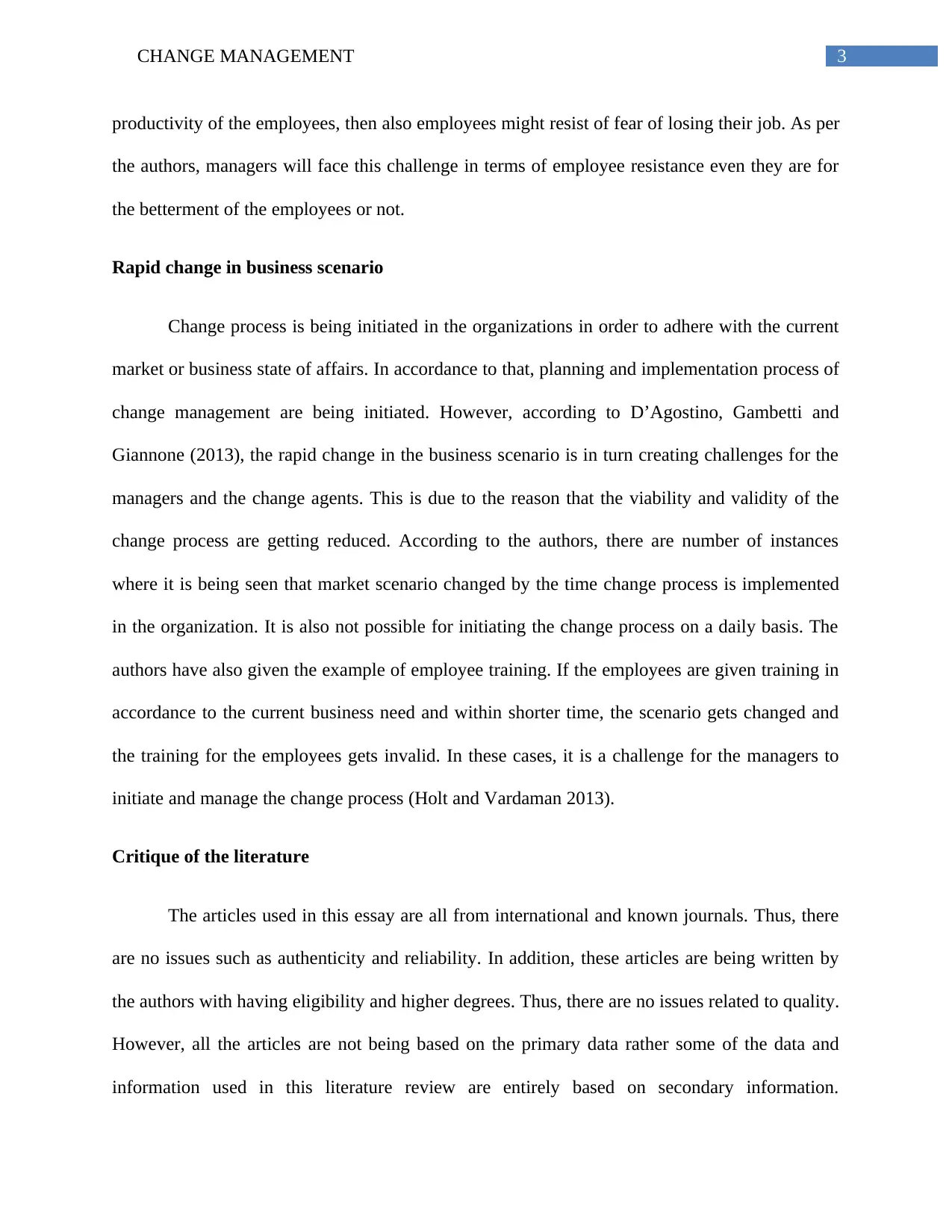
3CHANGE MANAGEMENT
productivity of the employees, then also employees might resist of fear of losing their job. As per
the authors, managers will face this challenge in terms of employee resistance even they are for
the betterment of the employees or not.
Rapid change in business scenario
Change process is being initiated in the organizations in order to adhere with the current
market or business state of affairs. In accordance to that, planning and implementation process of
change management are being initiated. However, according to D’Agostino, Gambetti and
Giannone (2013), the rapid change in the business scenario is in turn creating challenges for the
managers and the change agents. This is due to the reason that the viability and validity of the
change process are getting reduced. According to the authors, there are number of instances
where it is being seen that market scenario changed by the time change process is implemented
in the organization. It is also not possible for initiating the change process on a daily basis. The
authors have also given the example of employee training. If the employees are given training in
accordance to the current business need and within shorter time, the scenario gets changed and
the training for the employees gets invalid. In these cases, it is a challenge for the managers to
initiate and manage the change process (Holt and Vardaman 2013).
Critique of the literature
The articles used in this essay are all from international and known journals. Thus, there
are no issues such as authenticity and reliability. In addition, these articles are being written by
the authors with having eligibility and higher degrees. Thus, there are no issues related to quality.
However, all the articles are not being based on the primary data rather some of the data and
information used in this literature review are entirely based on secondary information.
productivity of the employees, then also employees might resist of fear of losing their job. As per
the authors, managers will face this challenge in terms of employee resistance even they are for
the betterment of the employees or not.
Rapid change in business scenario
Change process is being initiated in the organizations in order to adhere with the current
market or business state of affairs. In accordance to that, planning and implementation process of
change management are being initiated. However, according to D’Agostino, Gambetti and
Giannone (2013), the rapid change in the business scenario is in turn creating challenges for the
managers and the change agents. This is due to the reason that the viability and validity of the
change process are getting reduced. According to the authors, there are number of instances
where it is being seen that market scenario changed by the time change process is implemented
in the organization. It is also not possible for initiating the change process on a daily basis. The
authors have also given the example of employee training. If the employees are given training in
accordance to the current business need and within shorter time, the scenario gets changed and
the training for the employees gets invalid. In these cases, it is a challenge for the managers to
initiate and manage the change process (Holt and Vardaman 2013).
Critique of the literature
The articles used in this essay are all from international and known journals. Thus, there
are no issues such as authenticity and reliability. In addition, these articles are being written by
the authors with having eligibility and higher degrees. Thus, there are no issues related to quality.
However, all the articles are not being based on the primary data rather some of the data and
information used in this literature review are entirely based on secondary information.
Paraphrase This Document
Need a fresh take? Get an instant paraphrase of this document with our AI Paraphraser
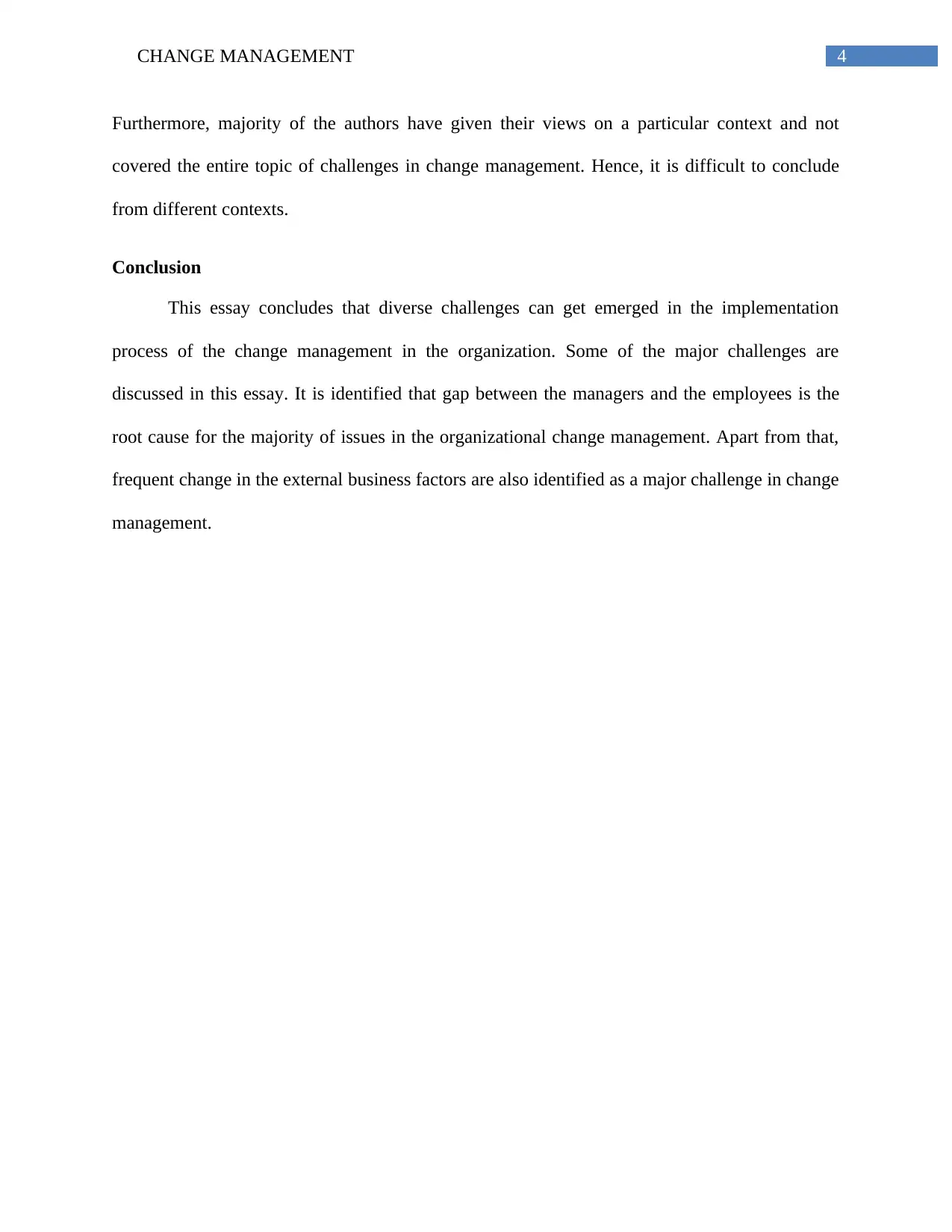
4CHANGE MANAGEMENT
Furthermore, majority of the authors have given their views on a particular context and not
covered the entire topic of challenges in change management. Hence, it is difficult to conclude
from different contexts.
Conclusion
This essay concludes that diverse challenges can get emerged in the implementation
process of the change management in the organization. Some of the major challenges are
discussed in this essay. It is identified that gap between the managers and the employees is the
root cause for the majority of issues in the organizational change management. Apart from that,
frequent change in the external business factors are also identified as a major challenge in change
management.
Furthermore, majority of the authors have given their views on a particular context and not
covered the entire topic of challenges in change management. Hence, it is difficult to conclude
from different contexts.
Conclusion
This essay concludes that diverse challenges can get emerged in the implementation
process of the change management in the organization. Some of the major challenges are
discussed in this essay. It is identified that gap between the managers and the employees is the
root cause for the majority of issues in the organizational change management. Apart from that,
frequent change in the external business factors are also identified as a major challenge in change
management.
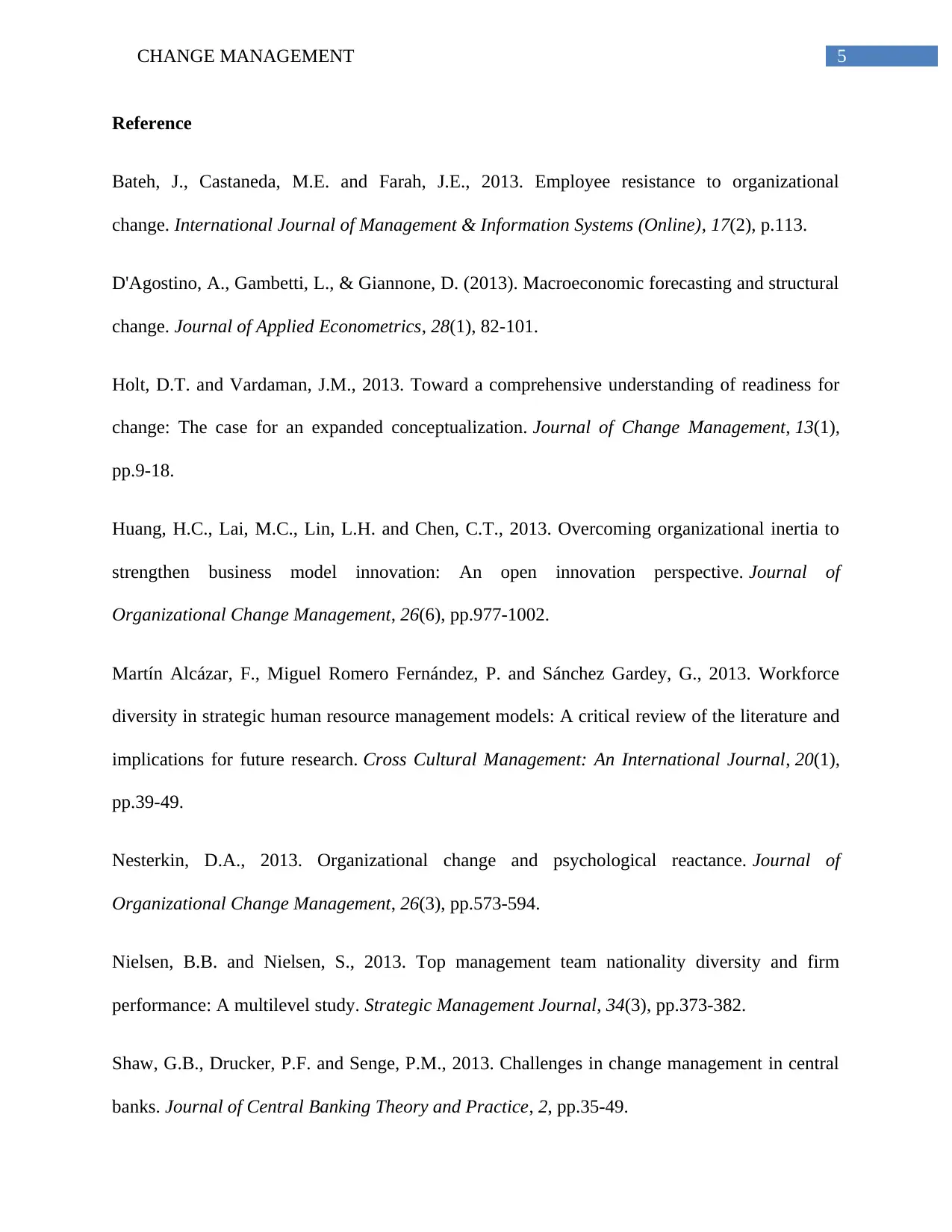
5CHANGE MANAGEMENT
Reference
Bateh, J., Castaneda, M.E. and Farah, J.E., 2013. Employee resistance to organizational
change. International Journal of Management & Information Systems (Online), 17(2), p.113.
D'Agostino, A., Gambetti, L., & Giannone, D. (2013). Macroeconomic forecasting and structural
change. Journal of Applied Econometrics, 28(1), 82-101.
Holt, D.T. and Vardaman, J.M., 2013. Toward a comprehensive understanding of readiness for
change: The case for an expanded conceptualization. Journal of Change Management, 13(1),
pp.9-18.
Huang, H.C., Lai, M.C., Lin, L.H. and Chen, C.T., 2013. Overcoming organizational inertia to
strengthen business model innovation: An open innovation perspective. Journal of
Organizational Change Management, 26(6), pp.977-1002.
Martín Alcázar, F., Miguel Romero Fernández, P. and Sánchez Gardey, G., 2013. Workforce
diversity in strategic human resource management models: A critical review of the literature and
implications for future research. Cross Cultural Management: An International Journal, 20(1),
pp.39-49.
Nesterkin, D.A., 2013. Organizational change and psychological reactance. Journal of
Organizational Change Management, 26(3), pp.573-594.
Nielsen, B.B. and Nielsen, S., 2013. Top management team nationality diversity and firm
performance: A multilevel study. Strategic Management Journal, 34(3), pp.373-382.
Shaw, G.B., Drucker, P.F. and Senge, P.M., 2013. Challenges in change management in central
banks. Journal of Central Banking Theory and Practice, 2, pp.35-49.
Reference
Bateh, J., Castaneda, M.E. and Farah, J.E., 2013. Employee resistance to organizational
change. International Journal of Management & Information Systems (Online), 17(2), p.113.
D'Agostino, A., Gambetti, L., & Giannone, D. (2013). Macroeconomic forecasting and structural
change. Journal of Applied Econometrics, 28(1), 82-101.
Holt, D.T. and Vardaman, J.M., 2013. Toward a comprehensive understanding of readiness for
change: The case for an expanded conceptualization. Journal of Change Management, 13(1),
pp.9-18.
Huang, H.C., Lai, M.C., Lin, L.H. and Chen, C.T., 2013. Overcoming organizational inertia to
strengthen business model innovation: An open innovation perspective. Journal of
Organizational Change Management, 26(6), pp.977-1002.
Martín Alcázar, F., Miguel Romero Fernández, P. and Sánchez Gardey, G., 2013. Workforce
diversity in strategic human resource management models: A critical review of the literature and
implications for future research. Cross Cultural Management: An International Journal, 20(1),
pp.39-49.
Nesterkin, D.A., 2013. Organizational change and psychological reactance. Journal of
Organizational Change Management, 26(3), pp.573-594.
Nielsen, B.B. and Nielsen, S., 2013. Top management team nationality diversity and firm
performance: A multilevel study. Strategic Management Journal, 34(3), pp.373-382.
Shaw, G.B., Drucker, P.F. and Senge, P.M., 2013. Challenges in change management in central
banks. Journal of Central Banking Theory and Practice, 2, pp.35-49.
⊘ This is a preview!⊘
Do you want full access?
Subscribe today to unlock all pages.

Trusted by 1+ million students worldwide
1 out of 6
Related Documents
Your All-in-One AI-Powered Toolkit for Academic Success.
+13062052269
info@desklib.com
Available 24*7 on WhatsApp / Email
![[object Object]](/_next/static/media/star-bottom.7253800d.svg)
Unlock your academic potential
Copyright © 2020–2025 A2Z Services. All Rights Reserved. Developed and managed by ZUCOL.




